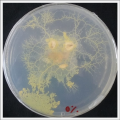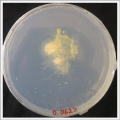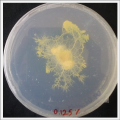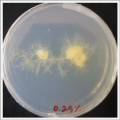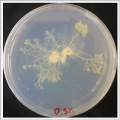Paola S. Calderón/Project: Specimen ''Physarum Polycephalum''.: Difference between revisions
No edit summary |
|||
| Line 5: | Line 5: | ||
The original idea was to see if there was any relation between Alii Vibrio fischeri (a specimen that life in warm around 20°C oceans) & Physarum Polycephalum (a specimen that life's in the forest in warm temperatures 20°C). In order to test this, I made an investigation around the two specimens. The second step was to cultivate both of them, sadly the extraction of the first specimen from an octopus didn't give results, so I redirected my project into teaching Physarum Polycephalum to adapt to salinity environments. | The original idea was to see if there was any relation between Alii Vibrio fischeri (a specimen that life in warm around 20°C oceans) & Physarum Polycephalum (a specimen that life's in the forest in warm temperatures 20°C). In order to test this, I made an investigation around the two specimens. The second step was to cultivate both of them, sadly the extraction of the first specimen from an octopus didn't give results, so I redirected my project into teaching Physarum Polycephalum to adapt to salinity environments. | ||
[[File:52h salinity medium.mp4]] | [[File:52h salinity medium.mp4|1500px]] | ||
Here can be seen a video around how specimens that were teached to live in different salinity mediums behave when they have the possibility to move between different salinity mediums (Between 0% salinity and 0.5% salinity). It is a 52 h photage of Physarum Polycephalum in salinity medium. | Here can be seen a video around how specimens that were teached to live in different salinity mediums behave when they have the possibility to move between different salinity mediums (Between 0% salinity and 0.5% salinity). It is a 52 h photage of Physarum Polycephalum in salinity medium. | ||
Revision as of 23:59, 27 March 2019
Physarum Polycephalum.
Project idea.
The original idea was to see if there was any relation between Alii Vibrio fischeri (a specimen that life in warm around 20°C oceans) & Physarum Polycephalum (a specimen that life's in the forest in warm temperatures 20°C). In order to test this, I made an investigation around the two specimens. The second step was to cultivate both of them, sadly the extraction of the first specimen from an octopus didn't give results, so I redirected my project into teaching Physarum Polycephalum to adapt to salinity environments.
Here can be seen a video around how specimens that were teached to live in different salinity mediums behave when they have the possibility to move between different salinity mediums (Between 0% salinity and 0.5% salinity). It is a 52 h photage of Physarum Polycephalum in salinity medium.
Investigation around the specimens.
In the following links can be found the investigation around the two specimens, the medium that they need and more.
/Investigation around Aliivibrio Fischeri.
/Investigation around Physarum Polycephalum.
Specimens Mediums.
- Medium A.F:
- NaCl 30 g
- Glycerol 1 g
- Pepton (Bacxto-peptone) 10 g
- Meat extract 3 g
- Made up with distilled water to 1000 ml
- Medium P.P:
- 100ml of distilled water
- 2g of agar
- Leaflets
Experimentation with the specimens.
In the following links can be found the diary of work made with each specimen, the experiments that were made with each of them, the experimentation with some mediums and more.
/Diary of work: Alii Vibrio Fischeri
/Diary of work: Physarum Polycephalum
Conclusions:
After making the salinity experiment with the Physarum Polycephalum, I get into the conclusion that this specimen can learn to survive in mediums that have salt concentrations. It can learn to survive in them in a process of increasing the salinity, but not if it is situated in a salinity medium without previous teaching.
After the experiment comes to a lot of questions that can be solved with further experiments like; 1) how fast does it forget? 2) Does it remember after a period of sleep? 3) Is the sclerotium cultivation possible after a period of time?, 4) the specimen showed troubles to find the food in high levels of salinity, Does the levels of NaCl affect the ability of the specimen to find the food?
Salinity Percentage Mediums: Strains P.p.P
During the time that I adopted this specimen, I made many tests in order to get to know and understand the specimen. I'm also taking the class of "DIY Bio; doing things with biology", where I made many tests in terms of food, temperature, and light. This information can be found on the following websites:
